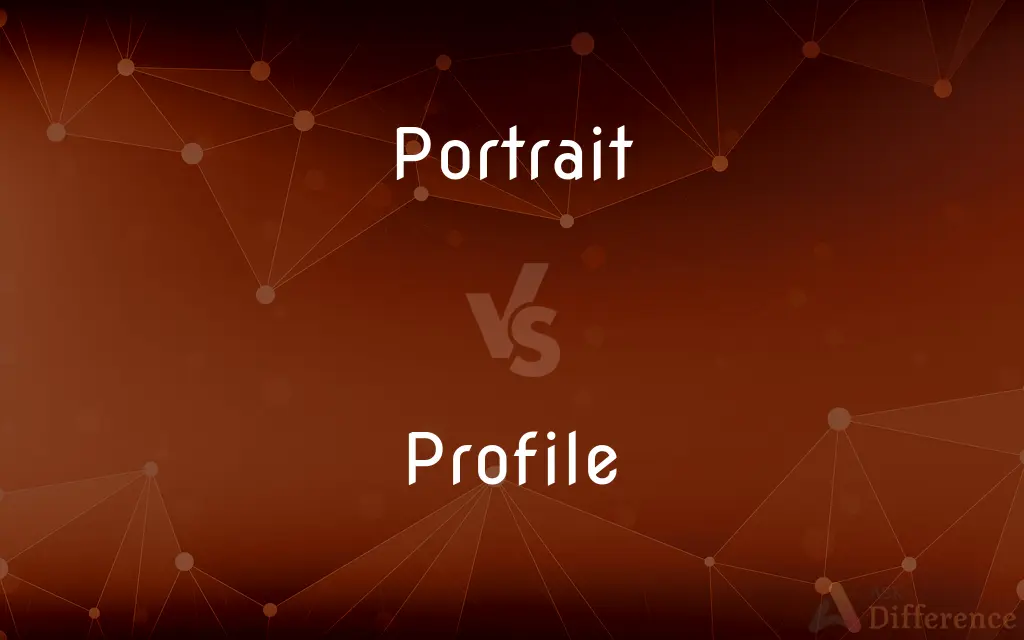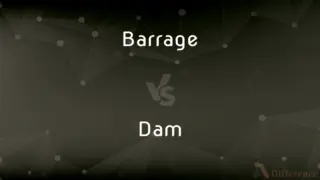Portrait vs. Profile — What's the Difference?
Edited by Tayyaba Rehman — By Fiza Rafique — Updated on March 5, 2024
Portraits capture a subject's face and expression from the front or side, focusing on personality, while profile views show one side of the face, emphasizing silhouette and features.

Difference Between Portrait and Profile
Table of Contents
ADVERTISEMENT
Key Differences
A portrait is a representation of a person, often focusing on the face, with the aim of capturing the individual's personality, mood, and essence. This can be achieved through various mediums, including photography, painting, and sculpture. On the other hand, a profile view is a specific type of portrait where the subject's face is seen from the side. This perspective emphasizes the silhouette of the face, highlighting the contours of the nose, jawline, and forehead, and is often used to capture a person's physical traits rather than their personality or emotional state.
While portraits can be taken or painted in both formal and informal settings, they often aim to convey a deeper understanding or connection with the subject. They might include background elements or props that tell a story about the individual's life, interests, or status. Profile views, whereas, tend to be more focused on the aesthetic and structural qualities of the subject's face, offering a cleaner, more minimalist representation that can sometimes feel more detached or impersonal.
Lighting plays a crucial role in shaping the mood and focus of the piece. Soft, diffuse lighting can create a warm, inviting atmosphere, highlighting the subject's features gently. In contrast, profile views can benefit from stronger, more directional lighting to accentuate the face's outline and create a dramatic interplay of light and shadow.
The choice between a portrait and a profile view can also reflect cultural and historical preferences. Historically, profile views were popular in ancient and medieval art, symbolizing power, dignity, and grace. Modern portraits, on the other hand, often seek to capture the individuality and complexity of the subject, reflecting contemporary values of authenticity and emotional depth.
Both portrait and profile views require a keen eye for composition and detail. In portraits, the artist or photographer must consider the subject's pose, expression, and the context provided by the background and attire. For profiles, the challenge lies in capturing the essence of the subject's features in a way that is both accurate and flattering, requiring precise control over angle and perspective.
ADVERTISEMENT
Comparison Chart
Perspective
Front or slight angle
Side view
Focus
Personality and expression
Silhouette and features
Lighting
Varied, can be soft or dramatic
Often uses directional lighting
Historical Use
Broad, includes intimate and personal depictions
Associated with power and formality
Composition Challenges
Capturing expression, mood, background context
Accurate depiction of facial contours, angle precision
Compare with Definitions
Portrait
Emphasizes personality and mood.
The portrait's warm lighting highlighted his thoughtful expression.
Profile
Side view of a person's face.
The profile showed the sharp contours of his jawline.
Portrait
A depiction focusing on a person's face and expression.
The portrait captured her smile beautifully.
Profile
Emphasizes silhouette and facial features.
Her profile was defined by the elegant curve of her nose.
Portrait
Can be full-body or bust.
The artist painted a full-body portrait of the dancer.
Profile
Requires precise angle control.
The photographer adjusted her position to capture the perfect profile.
Portrait
Uses varied lighting techniques.
The portrait used soft lighting to enhance her features gently.
Profile
Often minimalist.
The profile drawing used clean lines for a striking effect.
Portrait
Often includes background elements.
The portrait featured a library, hinting at the subject's love of books.
Profile
Can suggest formality or power.
The historical figure's profile was used on the coin.
Portrait
A portrait is a painting, photograph, sculpture, or other artistic representation of a person, in which the face and its expression is predominant. The intent is to display the likeness, personality, and even the mood of the person.
Profile
A side view of an object or structure, especially of the human head.
Portrait
A likeness of a person, especially one showing the face, that is created by a painter or photographer, for example.
Profile
A representation of an object or structure seen from the side.
Portrait
A verbal representation or description, especially of a person.
Profile
An outline of an object.
Portrait
A dramatic representation of a character
The actor's portrait of the famous general.
Profile
Degree of exposure to public notice; visibility
Preferred to keep a low profile.
Portrait
A word picture of a person's appearance and character
Profile
A set of characteristics that identify or are thought to identify a particular type of person
The police assembled a profile of the car thief.
Portrait
Any likeness of a person;
The photographer made excellent portraits
Profile
Reputation, prominence; noticeability.
Acting is, by nature, profession in which one must keep a high profile.
Profile
A human head represented sidewise, or in a side view; the side face or half face.
Profile
Represent in profile, by drawing or painting
Common Curiosities
How do portraits convey personality?
Through facial expressions, body language, and sometimes background elements.
Why might an artist choose a profile view?
To highlight the subject's facial contours or for stylistic or symbolic reasons.
What is a portrait?
A depiction that focuses on capturing a person's face, expression, and personality.
What is a profile?
A side view of a person's face, emphasizing their silhouette and facial features.
Can portraits be of non-human subjects?
Yes, animals or even objects can be depicted in a "portrait-like" manner to convey character or importance.
Can a portrait include more than one person?
Yes, group portraits can capture relationships and interactions between subjects.
How do background elements contribute to a portrait?
They provide context, suggest personality traits, or tell a story about the subject.
Are profile views less expressive than full-face portraits?
Not necessarily; they can convey a different kind of aesthetic or emotional message.
How do artists capture emotion in portraits?
Through careful attention to facial expressions, posture, and eyes.
Do cultural differences affect portrait styles?
Yes, cultural influences can shape the approach to portraiture, including the use of color, composition, and symbolism.
What role does lighting play in portrait photography?
It shapes the mood, highlights features, and can convey depth and texture.
What makes a portrait realistic?
Detailed depiction of features, accurate lighting, and texture that convey a lifelike appearance.
Can digital photography affect portrait styles?
Yes, digital techniques offer new possibilities for editing and effects that can enhance or alter the portrayal.
What is the historical importance of profile portraits?
They have been used for centuries to denote status, identity, and power, especially in coinage and sculptures.
What is the significance of the angle in profile views?
It affects how the subject's features are perceived, influencing the portrait's overall impact.
Share Your Discovery

Previous Comparison
Barrage vs. Dam
Next Comparison
Swat vs. FbiAuthor Spotlight
Written by
Fiza RafiqueFiza Rafique is a skilled content writer at AskDifference.com, where she meticulously refines and enhances written pieces. Drawing from her vast editorial expertise, Fiza ensures clarity, accuracy, and precision in every article. Passionate about language, she continually seeks to elevate the quality of content for readers worldwide.
Edited by
Tayyaba RehmanTayyaba Rehman is a distinguished writer, currently serving as a primary contributor to askdifference.com. As a researcher in semantics and etymology, Tayyaba's passion for the complexity of languages and their distinctions has found a perfect home on the platform. Tayyaba delves into the intricacies of language, distinguishing between commonly confused words and phrases, thereby providing clarity for readers worldwide.














































